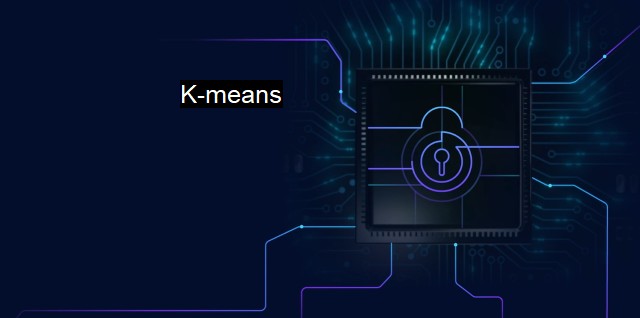What are K-means?
The Role of K-Means Clustering in Cybersecurity and Antivirus: Understanding the Application and Benefits of This Well-Known Data Clustering Algorithm
Developed by Stuart Lloyd at the Bell Laboratories in 1957, K-means is a popular method of cluster analysis. The method aims at partitioning a set of 'n' observations using the 'k' number of clusters so that each observation belongs to the nearest cluster, which is typically measured by the mean.The K-means algorithm is a tool set to perform exploratory examination over a set of data. Utilizing clustering, it provides an insightful analysis, segregating similar data into groups. The primary aim of the K-means algorithm is determining the underlying patterns and behaviors in the dataset where questions or scenarios might be unclear.
An exponential growth in threats, threats sources, and attack vectors, all climbing at an alarming rate has been observed. For this purpose, more reliable, efficient, and accurate solutions are required. It is in this context that K-means algorithm finds its application.
In this line of work, segregating threats based on various factors like damage, severity, origin, and threat type would help provide a more efficient and prompt solution. Therefore, the K-means algorithm helps structure the multitude of data coming from such resources.
In the context of antivirus, K-means clustering can assist in file analysis. One core component of an antivirus operation is to scan individual files to identify potential malware. Each file comprises a massive amount of data and categorizing similar types of files can expedite scanning operations.
By employing the K-means clustering algorithm, antivirus systems can effectively categorize similar files based on data characteristics. When a nefarious file is flagged, the antivirus can then promptly assess other files in that same cluster. This dramatically reduces the scale and complexity of the task at hand by concentrating efforts on a potential 'hot spot' rather than scattering across an undifferentiated mass of data.
Intrusion detection systems (IDS), a fundamental part of cybersecurity platforms, heavily depend on a machine learning approach to identify irregular activities within the system. It's virtually impossible to monitor a network manually considering the exponential increase in the number of interconnected devices. The K-means algorithm is extensively used in intrusion detection systems to classify network transactions into ordinary and potential intrusions.
For instance, suppose an intruder is trying to carry out a Distributed Denial of Service (DDoS) attack. In that case, there will be a sudden flooding of network packets from random IPs within a specific time duration. Here, employing K-means clustering to categorize ordinary and extraordinary activities can facilitate quick detection of this irregular behavior.
Similarly, for various phishing attacks leading to ransomware, the content and nature of emails can be clustered. Here, unsolicited emails and phishing platforms typically demonstrating similar patterns can be detected easily.
K-means concept brings in an efficient layer of abstraction, allowing tech professionals to see through the scattered information and garner insights into the potential threats that loom over their data systems. it is essential to acknowledge that utilizing K-means clustering is going to be one layer of a multi-onion defense approach. Cybersecurity requires a multi-faceted approach that incorporates various tactics, tools, and defensive strategies. Using K-means clustering is a proactive step towards consolidated security but must be incorporated as a part of a broader security protocol.
The technology landscape evolves at an exponential pace, and so does the scope for crimes in this space. Hence, there is a paramount need for various data sciences such as cluster analysis and application of the K-means algorithm for analyzing and detecting cyber threats. Importantly, it aids in predicting, identifying, and warding off future hazards before they can inflict damage. That is the main aim of cybersecurity - constant vigil, accurate predictions, and consistent effort towards securing all data.

K-means FAQs
What is k-means and how is it used in cybersecurity?
K-means is a clustering algorithm that is commonly used in cybersecurity to identify patterns and anomalies in large data sets. It can be used to group similar features of malware or to segment network traffic for analysis.How does k-means work?
K-means works by partitioning a data set into clusters based on similarity. It starts by randomly assigning each data point to a cluster center, and then iteratively refines the clusters by reassigning points to new centers based on the distance between the point and the center.What are the advantages of using k-means in antivirus detection?
One advantage of using k-means in antivirus detection is that it can handle large data sets more efficiently than other machine learning algorithms. It can also identify previously unknown threats by clustering similar activities or behaviors.What are some potential drawbacks of using k-means in cybersecurity?
One potential drawback of using k-means in cybersecurity is that it requires pre-determined parameters, such as the number of clusters, which can be difficult to determine. It also assumes that all clusters are spherical and the data is normally distributed, which may not be the case in complex cybersecurity environments.Related Topics
Anomaly detection Behavioral analysis Malware analysis Vulnerability analysis Intrusion detection
| | A | | | B | | | C | | | D | | | E | | | F | | | G | | | H | | | I | | | J | | | K | | | L | | | M | |
| | N | | | O | | | P | | | Q | | | R | | | S | | | T | | | U | | | V | | | W | | | X | | | Y | | | Z | |
| | 1 | | | 2 | | | 3 | | | 4 | | | 7 | | | 8 | | |||||||